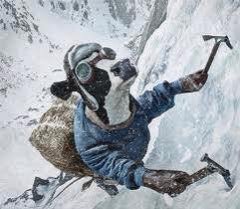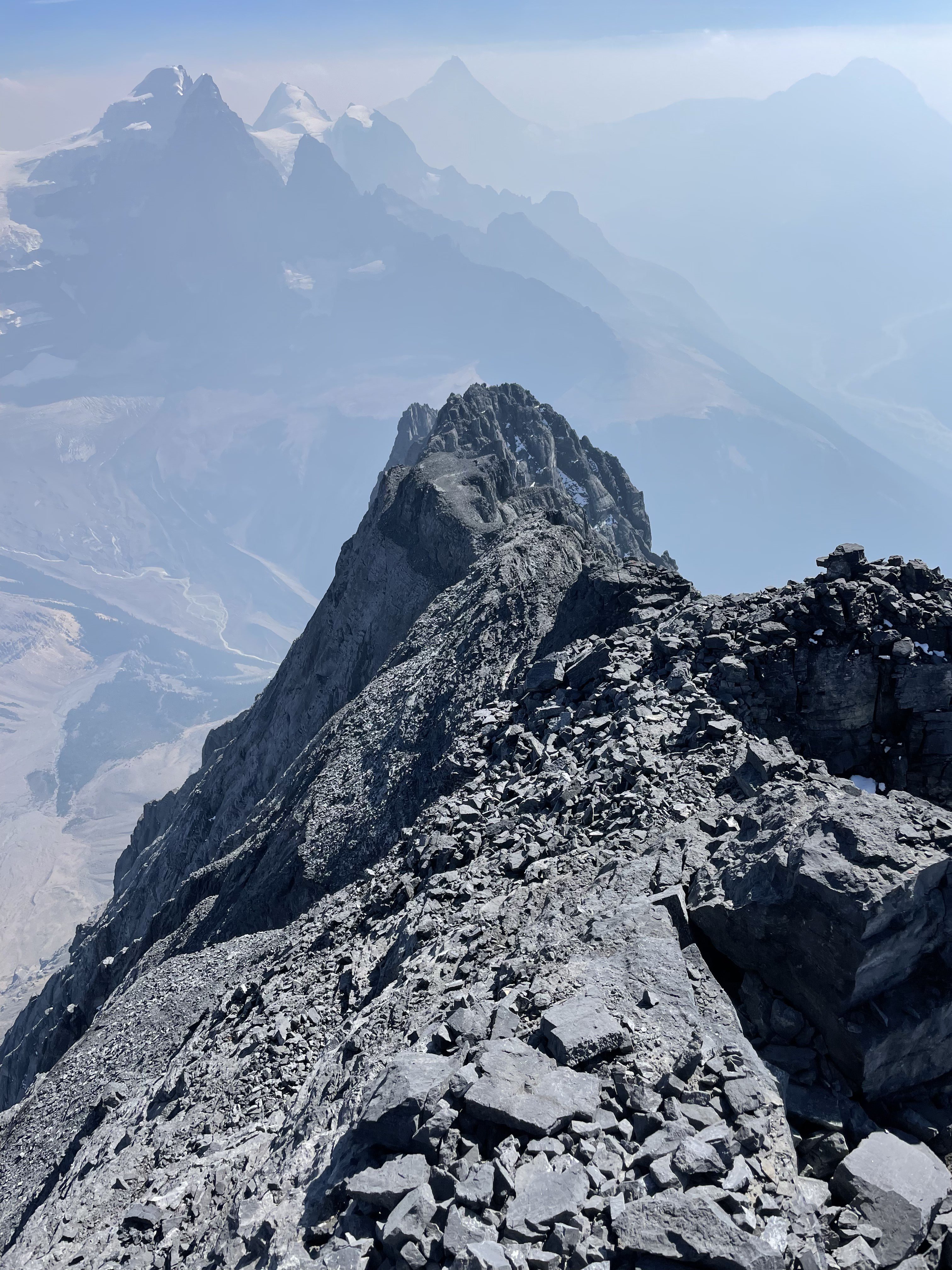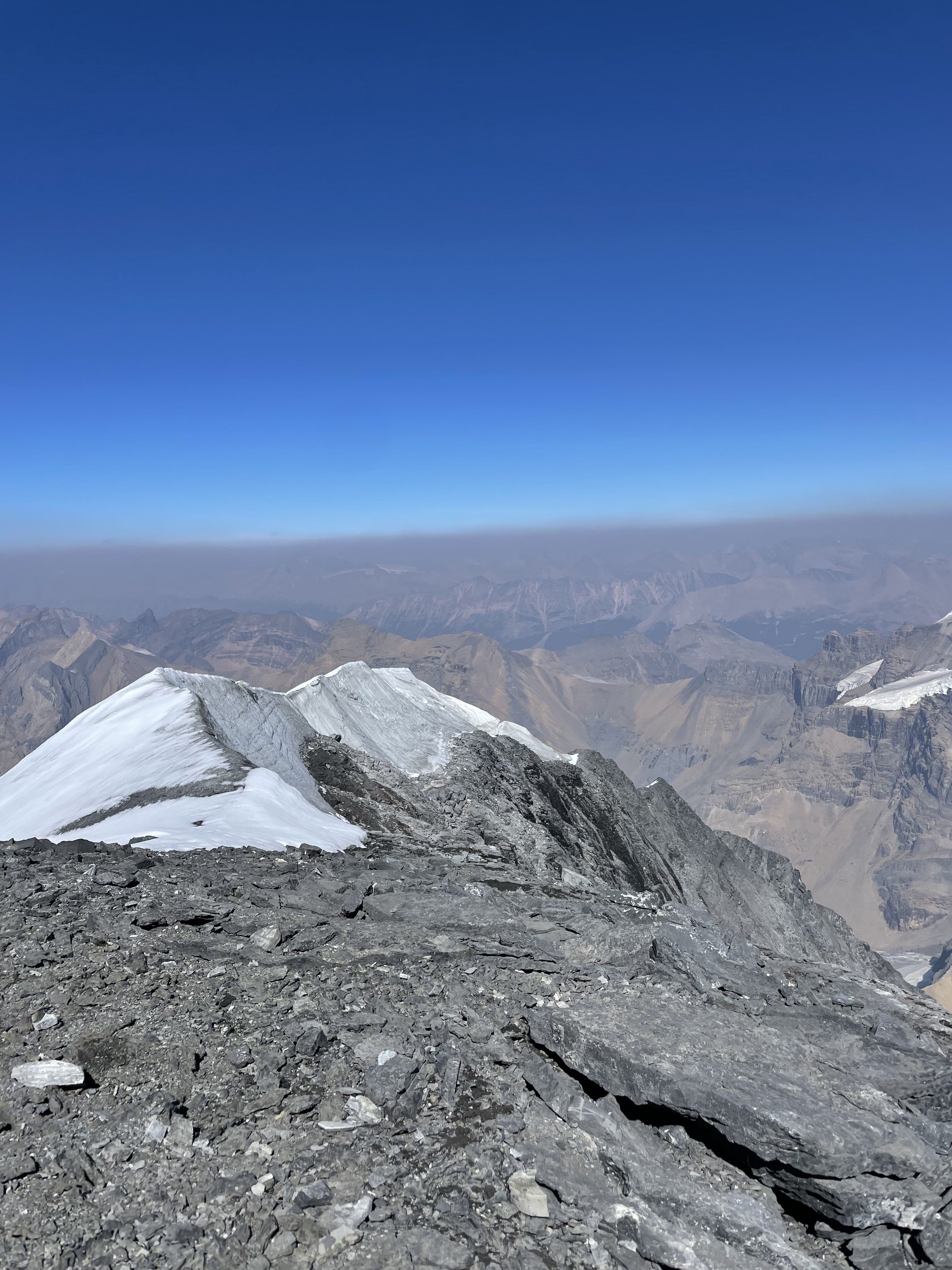All Activity
- Today
-
[TR] Mount Fairweather - Carpe Ridge (5.0, AI 3) - 5/24/24
Fairweather replied to eeelip's topic in Alaska
My dream climb! I wondered if it was even doable nowadays after The Smiley Project showed it deteriorating severely some ten or fifteen years ago. Thanks for sharing your trip with a now-62 year old guy who will likely miss this one in person. 🙂 -
PeteA joined the community
- Last week
-
thanks!
-
while it does not include any technical climbing, labyrinth mountain up just east of stevens pass is a pretty good kid alpinism route. 5 mile 2500ft gain trail to a lake with plenty of camping could be day one. labyrinth mountain lays above the lake and is a little bit visually intimidating. But there is a climber goat trail going to the summit with a 8 ft scramble at top. views good with a couple hours from the lake. https://www.alltrails.com/explore/trail/us/washington/labyrinth-mountain--2
-
[TR] Mt. Hood - Eliot Glacier/Sunshine Route 05/31/2024
Pinrouze replied to jstluise's topic in Oregon Cascades
Mt. Hood sounds like a challenging but exciting route. I wonder how long it took you to make that ascent and descent? -
Pinrouze joined the community
-
Trip: Mt. Hood - Eliot Glacier/Sunshine Route Trip Date: 05/31/2024 Trip Report: We set out on Friday afternoon from the Tilly Jane Trailhead with Mt. Hood as our objective via the northside Sunshine Route. We had cool temps and blue skies which made for a great approach, but the forecast was calling for weather to move in Saturday afternoon with a significant amount of precipitation Saturday night into Sunday. The goal was to camp high on route Friday, summit Saturday morning, then descend the same route and get out before weather hit. Mt. Hood on the drive in from the north: Sunshine Route (Anderson Rock & Horseshoe Rock): We met two climbers at the trailhead who just finished a car-to-car of the Sunshine Route that morning so they were able to provide beta on the route. Conditions sounded great. They chose to descend the south side of Hood to their second car at Timberline and drive back to the trailhead, but said descending the route would be fine. This inspired confidence because while descending the route isn't unheard of, most parties will carry-over to avoid the downclimb. We considered a carry-over, but preferred to keep pack weights low on summit day. After leaving the trailhead we made our way up the dry ski trail to the Tilly Jane A-Frame where we first encountered snow. From there we followed the footprints in the direction of the Cooper Spur Trail and soon we were at the Cooper Spur shelter for a quick break before making our way towards the Eliot Glacier. A large cairn marked the start of the climbers trail down the moraine which we followed to begin the glacier crossing. The snow was quite warm by then which made for some deep steps while crossing the glacier, but at least we weren't postholing. No glacier gear was needed here. A short time later we were ascending the ramp on the climber's right of the glacier which put us on the main approach to the Sunshine Route. We climbed further to 8,450' where we decided to set up camp for the night. After making some water for the following day and having a bite, we tried to get some sleep. We were the only party on the Sunshine Route. Eliot Glacier: The morning came fast and the temp dropped into the mid-30s with an increasing breeze. We reluctantly got up and were back on the move at 6:30a, but this time with lighter packs and donning crampons. There was still a view of the upper mountain and summit, but the clouds were moving in quickly. We continued upwards towards the first steep feature of the route: Anderson Rock. Base of Anderson Rock with Horseshoe Rock above: Typically one would skirt Anderson Rock to the climber's right but as we were informed by the other climbers, there was already an established boot pack directly up the center because of the nice snow coverage. We took advantage of the steps from the previous parties and started up Anderson Rock. I had a single axe ready while my partner had one tool. The lower portion was steep snow which made climbing easy and secure, but higher up where the slope steepened (50+ deg) and had thinner snow coverage it turned into ice. I retrieved my tool for more security while my partner managed the icy section with his single. The ice had good purchase so after a bit of front pointing we were through it and on the more gradual slope leading up to Horseshoe Rock. Just finishing Anderson Rock: The bergschrund below Horseshoe Rock was filled in and looked to be passable at several locations which opened up many options for the ascent. Once again, the previous parties went straight up the middle and we could see the boot pack. We considered following, but were unsure if we would encounter similar icy conditions at some point. We opted to take the route to the climber's right of Horseshoe Rock thinking that would avoid any icy slopes. We remained unroped and after crossing the 'schrund we had a short traverse to gain the slopes to the right. The snow was just right and allowed for easy steps and axe plunging as we continued up the steep slopes (45+ deg). I used my axe and tool and my partner had two tools. With the snow conditions we had one could get by with a single axe, but I didn't mind the extra point of contact with both of us soloing. Fortunately we did not encounter any ice. The upper section did have a light crust, but it did not impact our climbing. With one step and axe plunge at a time, we cruised up the slope towards Cathedral Ridge. We did take a more direct route which put us on 55+ degree snow just below the ridge, but this could have been avoided by meandering climber's right slightly. Nevertheless, we were soon on the ridge and had nothing but easy climbing to the summit. By now the clouds were moved in but we still caught the occasional glimpse of the upper slopes. Soon we were on the main summit ridge where we encountered a couple parties that were climbing the main south side route and after a quick traverse we reached the summit in the clouds. We took a short break for pictures and food and water before making our way back down. Summit Ridge: Summit: By this time the upper mountain was fully in the clouds so we had poor visibility and had to rely on following our tracks back to where we gained Cathedral Ridge. We started the downclimb, facing into the slope and retracing our steps one at a time. Foot. Foot. Axe. Axe. Repeat. In short order we were crossing the bergschrund again and at the top of Anderson Rock. By this time the snow/ice had softened up so the upper section downclimbed fairly easily. After that it was off to the races and we plunge-stepped back to camp. Downclimbing Anderson Rock: Under the occasional light rain shower we packed up camp and started our descent out of the weather and back to the trailhead to complete a successful Mt. Hood trip! The Sunshine Route was great. Not super technical but the steep snow kept it interesting. And the views (when we had them) we're amazing. This was my first time on Mt. Hood and am wondering why it took me so long to get down there. I'll be back! Weather moving in: Approximate route up Anderson Rock and Horseshoe Rock: Day 1 2:00pm Start Tilly Jane Trailhead (3,820') to Camp (8,450'), 5hr20m, +4,630' Day 2 6:30am Start Camp (8,450') to Summit (11,249'), 4hr30m, +2,800' Summit (11,249') to Camp (8,450'), 2hr00m, -2,800' Camp (8,450') to Tilly Jane Trailhead (3,820'), 2hr45m, -4,630' Gear Notes: We brought 4 pickets and a few screws. We each had two axes. If we pitched it out the pickets would have come in handy. Screw(s) would have been useful for protecting the icy section we encountered on Anderson Rock, but the ice could have been avoided by going climber's right around Anderson Rock. If you manage to stay only on steep snow, a single axe could be enough but it wouldn't hurt to have a second just in case. Approach Notes: Approach via Tilly Jane and Cooper Spur Trail, then turn right at the Cooper Spur Shelter to cross the Eliot Glacier (moraine crossing marked large cairn). Cross Eliot Glacier and ascend snow ramp on right side at ~7,500' to gain the slope to the main route.
-
https://www.nps.gov/noca/planyourvisit/road-conditions.htm Both sides agree that it is open.
-
Does anyone know if the Silver Skagit road is open now to Hozomeen? All I see is this but not sure if I am to trust it: B.C. Highway Flood Recovery Projects - Silver Skagit Road - Province of British Columbia (gov.bc.ca)
-

[TR] Mount Alberta - Japanese Route (5.6) - 9/3/23
wdietsch replied to eeelip's topic in British Columbia/Canada
thanks for sharing ... great photos and write up -

Wanted: Used/discarded dynamic & static rope
Kletterhund replied to strongsexysmart's topic in The Yard Sale
I may have some retired ropes... Are you making rugs or wall hangings? I would be up to trade for some creative work. James -
ggres335 started following Mt Jefferson
-
Anyone summit this season? How's the final climb?
-

[TR] Mount Alberta - Japanese Route (5.6) - 9/3/23
mountainsloth replied to eeelip's topic in British Columbia/Canada
Cool climb and write up. I love these Canadian TRs popping up recently. -
denise joined the community
-
Thanks to everyone for all their kind comments. I’ve been meaning to post a comment on here for a while as an addendum, but as luck would have it, life’s gotten the best of me. Anyhow, when Zach and I climbed this route it was our first route in the Lillooet area and we had no sense for grades in the area. Not knowing the local grading, we graded on the conservative side, trying not to overstate anything. We went back later in that season and got on other Lillooet climbs and got a better sense of things. This climb definitely felt harder to us than anything on Carl’s Berg, and closer to Loose Lady or Shriek of the Sheep in terms of difficulty. Ultimately it's prob better for more opinions to get a consensus, but I didn't want to surprise anyone trying to get on this thing.
-
Diamonds joined the community
-
Preacherbear joined the community
-
ryoaken joined the community
-
Third person bailed on trip due to scheduling issues, so I'm looking for a third to join. Have experience with crevasse rescue, wfr, a lot of technical climbing experience but would feel better having a third on board as my partner isn't too experienced on glaciers.
- Earlier
-
Wow - congrats that is a massive route! Way to nail the weather window!!
-
skypainter joined the community
-
eeelip started following Samaya Radical 3 and [TR] Mount Alberta - Japanese Route (5.6) - 9/3/23
-
Ian and I left Chelan at 3:30pm on Thursday before Labor day with Ian and drove North towards Kelowna. We were intending to climb something on Mount Robson, but the the afternoon update on Mountain Forecast just did not leave us the window we were hoping for. At the last possible turn-off, we switched to our backup objective. Total drive time was around 12 hours since we took the Orville border crossing and there we’re some detours due to the ongoing Forrest fires. We stopped in a state park boat launch parking area to sleep from 10pm-5am, then resumed driving until we reached the pullout on Icefeilds Parkway at 11:30am MTN. We re-packed for our new objective and started out wading across the braided Sunwapta river. The deepest section was only around thigh-deep this time of year and the water was icy cold. We ditched our wet shoes and a few excess items, then started up the steep forested trail next to Woolley Creek. The trail was very obvious, and we had downloaded a gpx track I found from Steven Song. The trail followed the creek up above the treeline, then across a series of steep rocky inclines and rocky plateaus. All of this was well marked with cairns. Once we reached around 8,000’ at the head of the valley, we filled up water and took in the incredible views of Woolley & Diadem peak and the glaciers clinging to their steep cliffs. From 8000’ up to 9,400’, the trail gets steep and loose, which is indicative of the rest of the route. We slogged up the inconsistent loose/solid scree and reached the top of the pass around 4pm. As soon as we crested the pass, we were smacked in the face by 40mph winds and our first view of the intimidating East face of Mount Alberta. The Lloyd Mackay hut was 800’ below as well, and we had plenty of daylight to get there. We descended scree, then traversed water and gravel covered slabs, and finally ascended 100’ up to the hut and outhouse. The hut is small with similar amenities to the hut on Mount Assiniboine. Since it was only 5pm, we decided to descend the 800’ additional into the valley below and find a bivy site. After reaching the valley floor, we decided to filter water and build a small new bivy site on a few flat-ish boulders. We were in our sleeping bags by 8pm, and up at 6:30am the next morning (sunrise was 7am). We left our bivy gear and started up the lower scree slope. After 700’ or so, we followed a ledge due South until we reached a short 4th class gully that lead to another 1000’ of scree or so. From this, we ascended another 4th class gully, and traversed NE and up across increasingly loose scree. At around 9,500’, we entered a long 4th class gully which we climbed inside of and on the adjacent rock bands. At the top of the gully around 10,000’, we traversed on a ledge marked by cairns around several rock ribs until we could go no further, and started heading upward towards a rap anchor. This was where we found the first 5.6 pitch which was not difficult, but worth bringing out ropes/helmets for. I belayed Ian as he lead up on our 42m rope, and we started swapping leads from here. There is a ton of loose but easy 5th class climbing, and we essentially tried to move from rap anchor to rap anchor until reaching the ridge crest at 11,400’. It took us around 7 hours to reach the ridge from camp. There had to be 10+ (short) pitches of us simuling and swapping leads with our short rope and it was far more time consuming than I had hoped. The ridge traverse is also very long, and very exposed. There is rappel around 3/4 of the way to the summit. We left our rope hanging there for the way back. The exposure is very intimidating all along. We reached the summit at 3pm, took some drone footage, then reversed the ridge. From there, it was a mix of careful rappelling and tedious downclimbing due to our rope not being full length. We finally reached the base of our 15 rappels or so at 7:30, and made the loose descent to our bivy site just before dark at 9:15pm. The mental relief of getting back to camp was immense. We quickly filtered water, ate food, and went straight to bed. We awoke around 4:30am being pelted by rain, and scrambled to pack up our belongings and make a charge for the hut, which we reached at 5:30. We ate breakfast and power napped until 9:30. From there we hiked up and over the pass in the wind and howling rain, and made the horrible descent from there back down to 8000’. This was the most miserable part of the trip due to the inconsistency of the rock quality. I snapped both trekking poles descending the pass. From there, we donned our shells and made the final soaking wet slog down to the Sunwapta river. The crossing was higher than last time, about waist deep but we managed just fine. We reached the truck at 2pm on Sunday and started the long drive back. Overall, this climb’s location is incredible, and the views of Mount Columbia and its massive icefeild were unforgettable. The massive avalanches spilling over the cliffs in the background make for a wild and intimidating setting that none of the icefeild parkway motorists will ever experience. The climbing itself mostly sucked, and even though the grade is low, it is mentally taxing for a full day with a tedious approach/deproach. Our lesson learned from this climb: bring a full length rope for the big objectives. A video of our climb: Our gear list: https://www.packwizard.com/s/NUcioL6 GPX: https://www.alltrails.com/explore/recording/mount-alberta-japanese-route-cd61a58
-
Keep them coming eeelip! Thanks for the TR, it looked like quite the adventure.
-

[TR] Mount Fairweather - Carpe Ridge (5.0, AI 3) - 5/24/24
olyclimber replied to eeelip's topic in Alaska
Not bad form to share old TRs at all! This place is for sharing stories new and old. Thank you, great pictures and everything. If you ever have issues with the site again, there is a Contact Us form at the bottom of the page and I will help you. Thanks for sharing! -
Great find. Will keep an eye out for these as well. We have been using the Eldorado, but it is very heavy compared to these new DCF tents.
-
No. But here is another option similar in all specs. Due to the yen vs the dollar makes it bargain a compared to that tent. Looks like there is another order window in July. https://locusgear.com/products/djedi-dcf-b I have a Locus Gear tent (not this one), and the quality is top notch.
-
Anybody have first hand experience with the Samaya Radical 3 tent? Seems like about the most expensive tent on the market but the weight is insane… https://us.samaya-equipment.com/collections/tentes/products/samaya-radical3
-
isaaacporter joined the community
-
I'm a big fan of his memoir. I have too many books and it's survived many purges: Memoirs of a Mountain Guide. Here's to a life well-lived!
-
Not in the least! We love it all, past or present. Well done on a major objective!
-
https://www.columbian.com/news/2024/may/28/100-summits-bulgers-in-a-season-documentary-about-camas-grad-ready-for-screening/
-
Way to (Allen) Carpe diem on a beautiful line.












